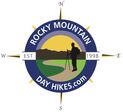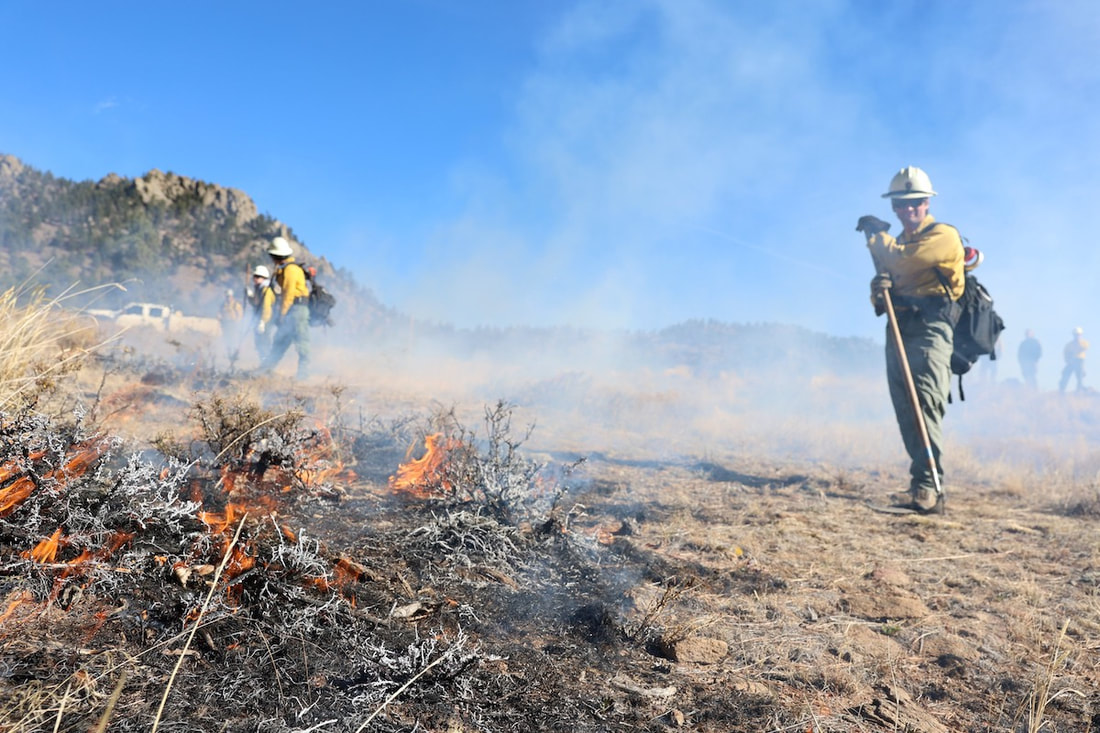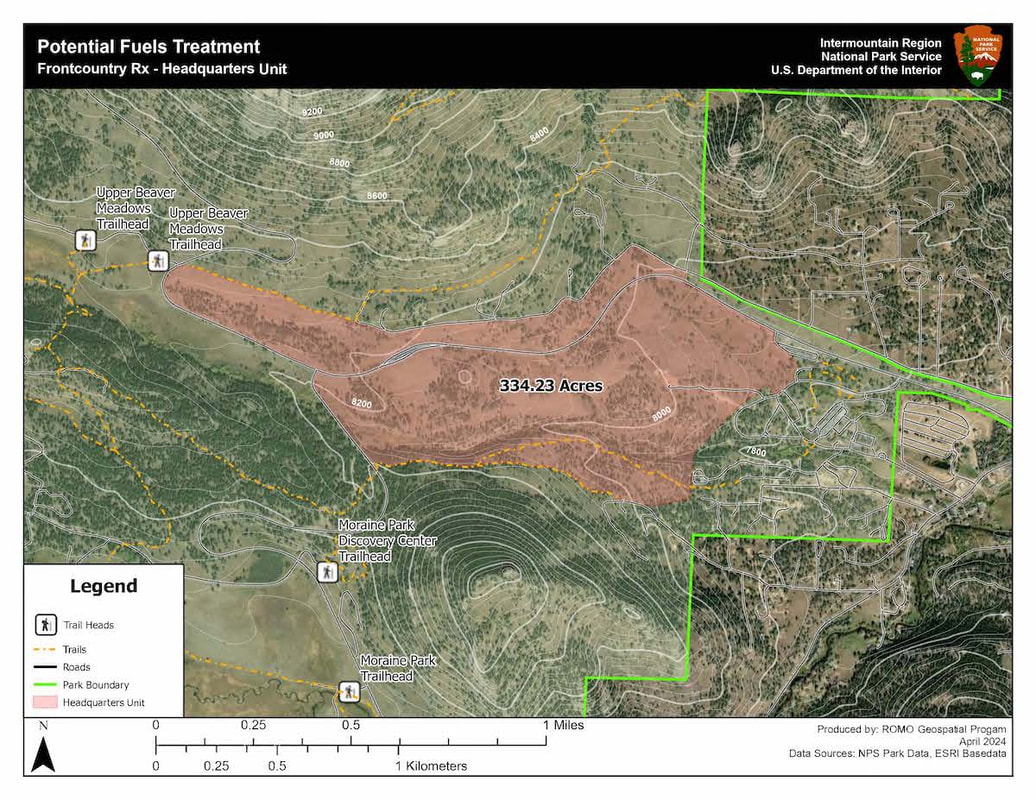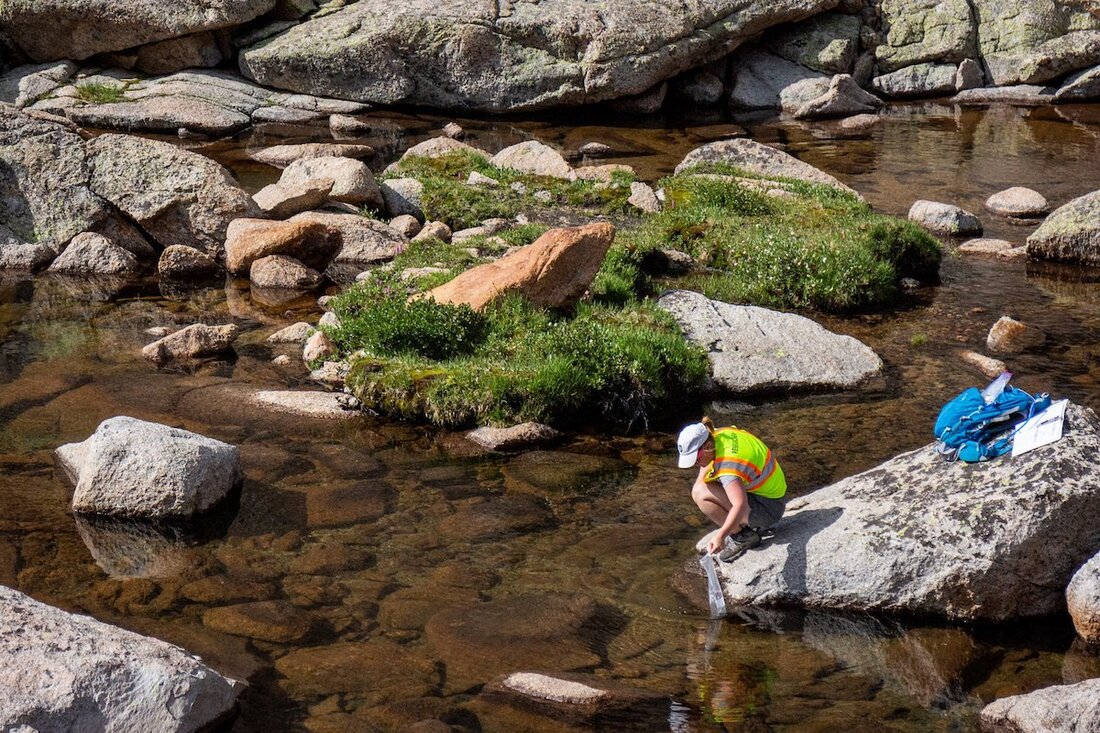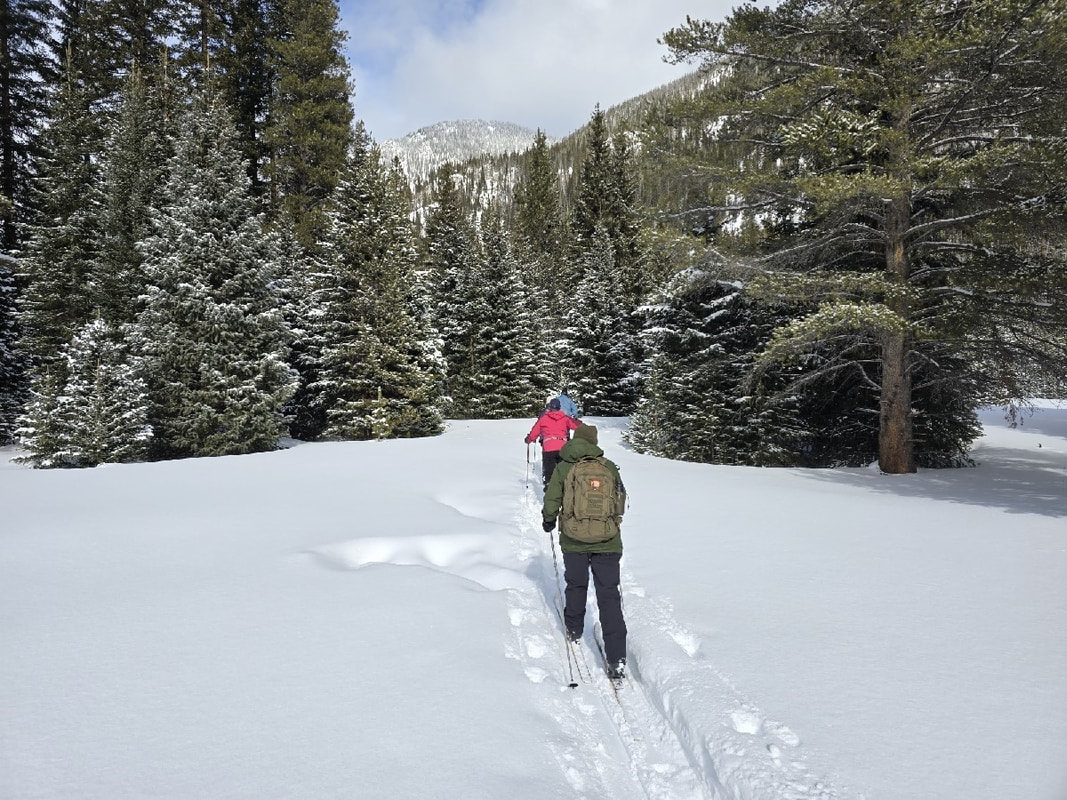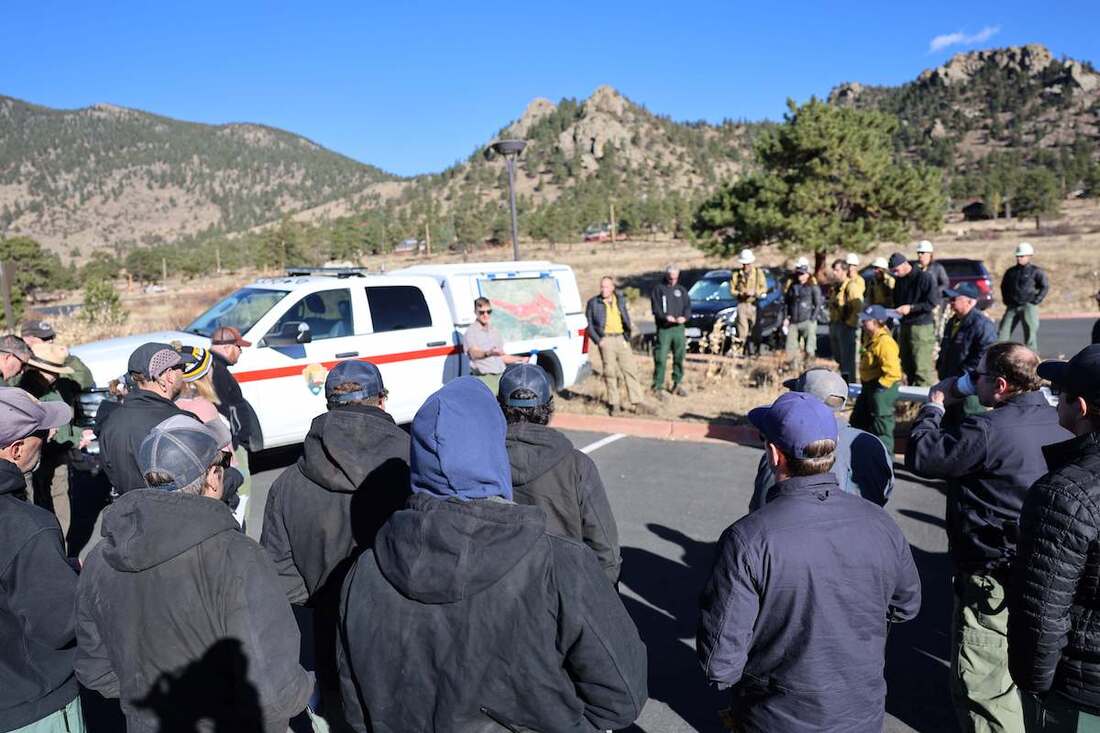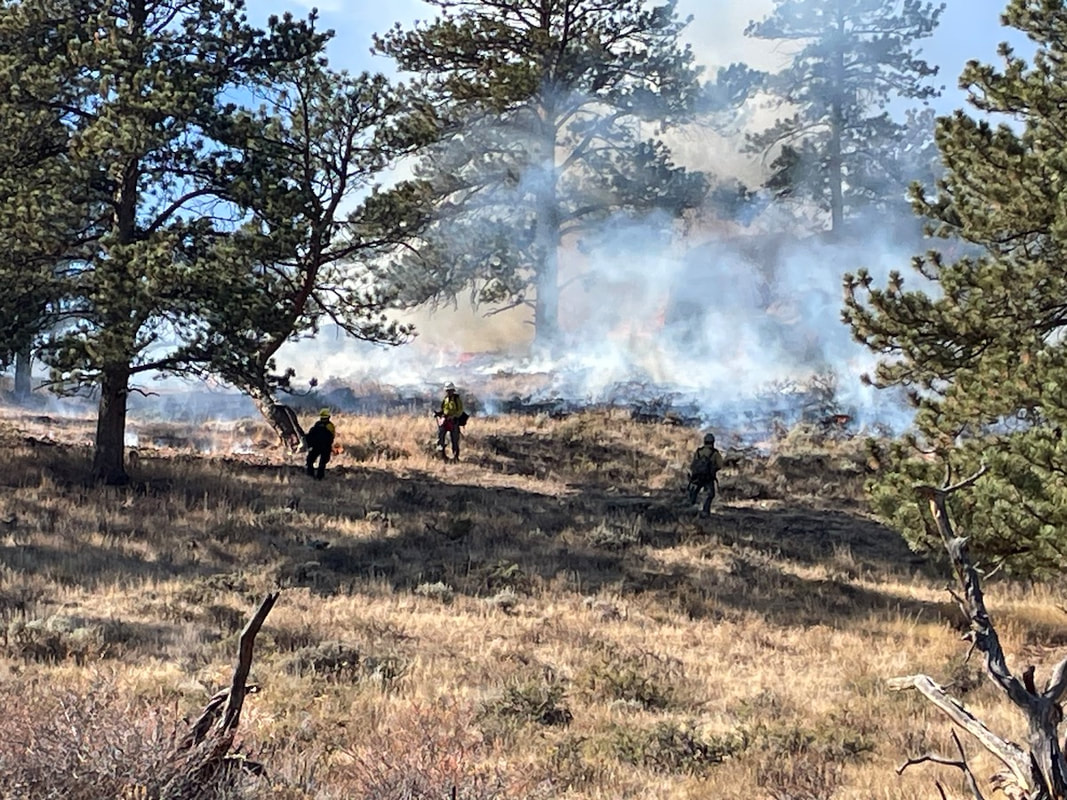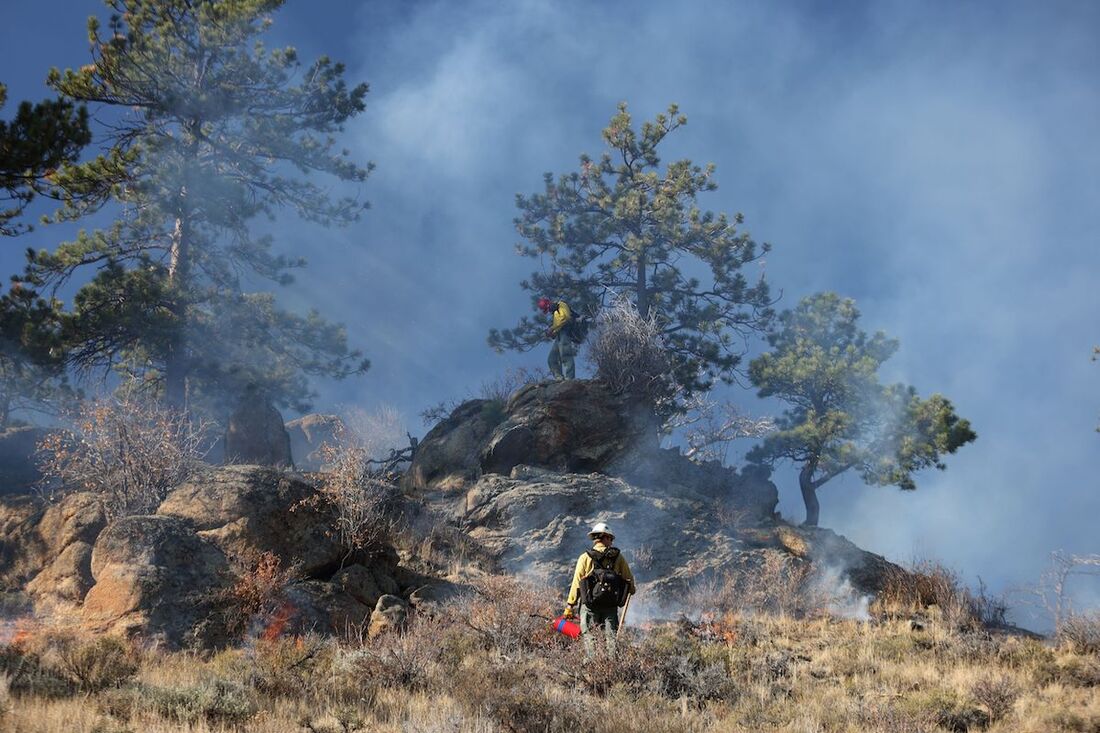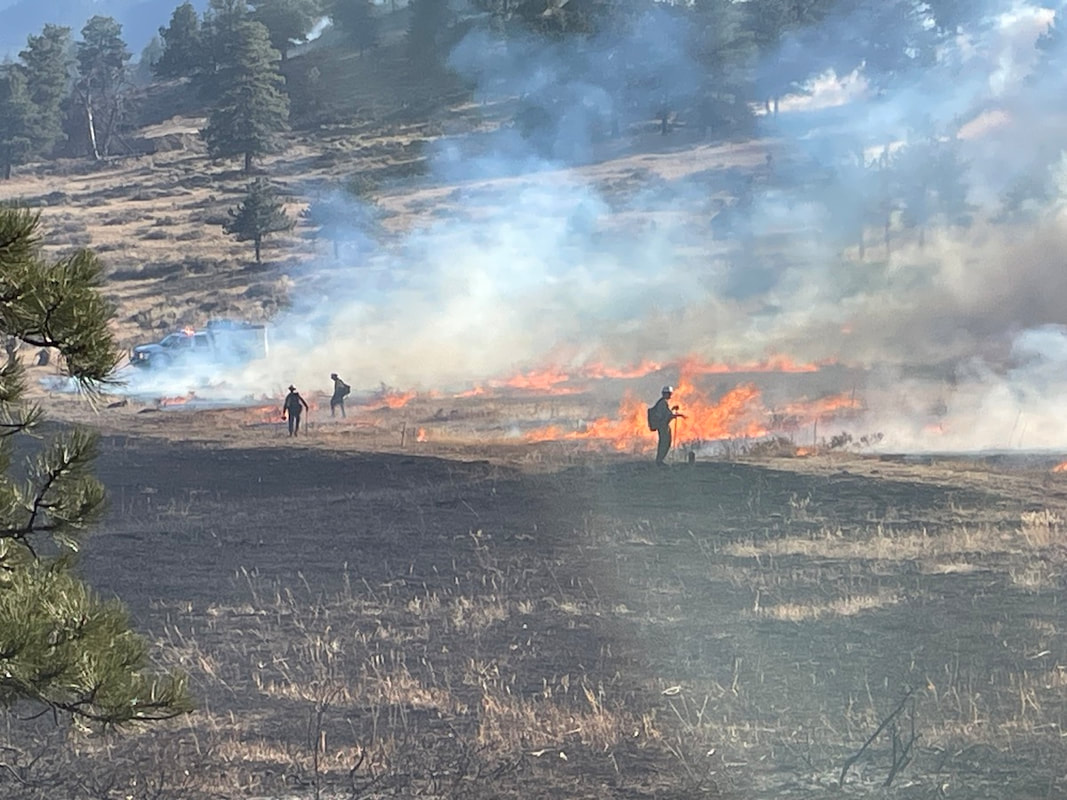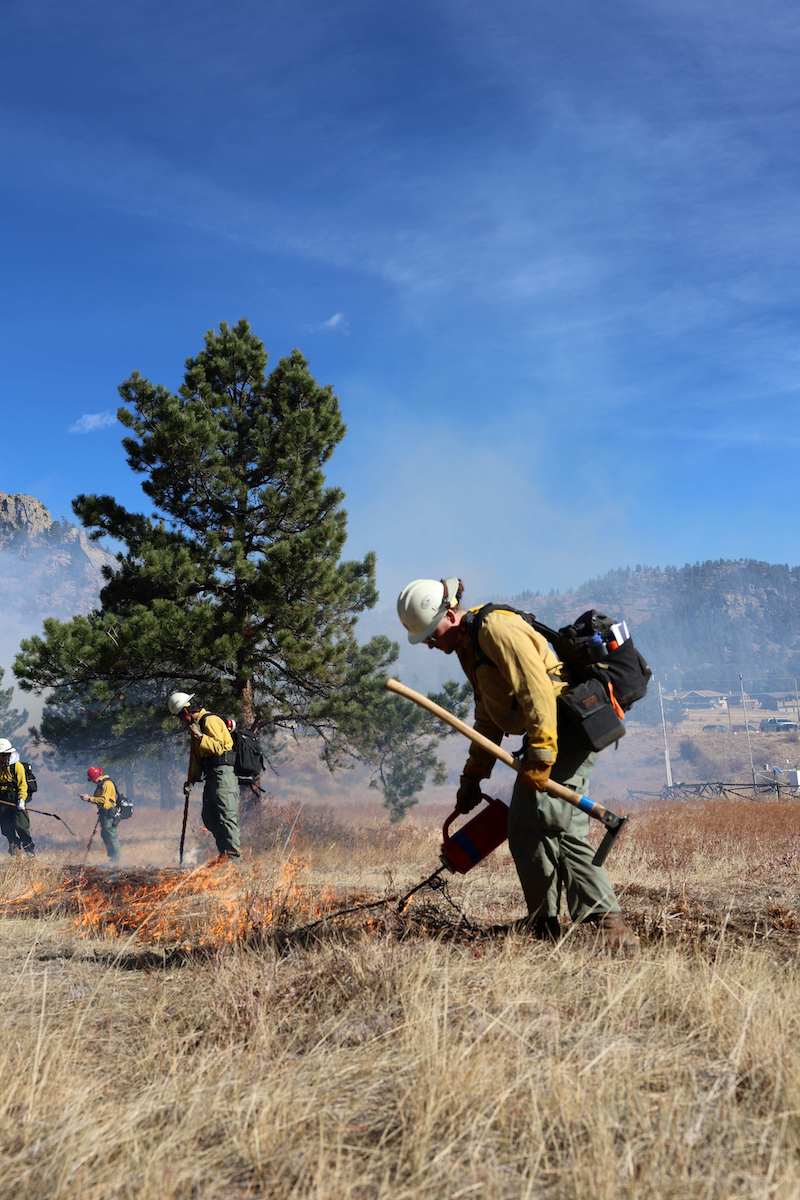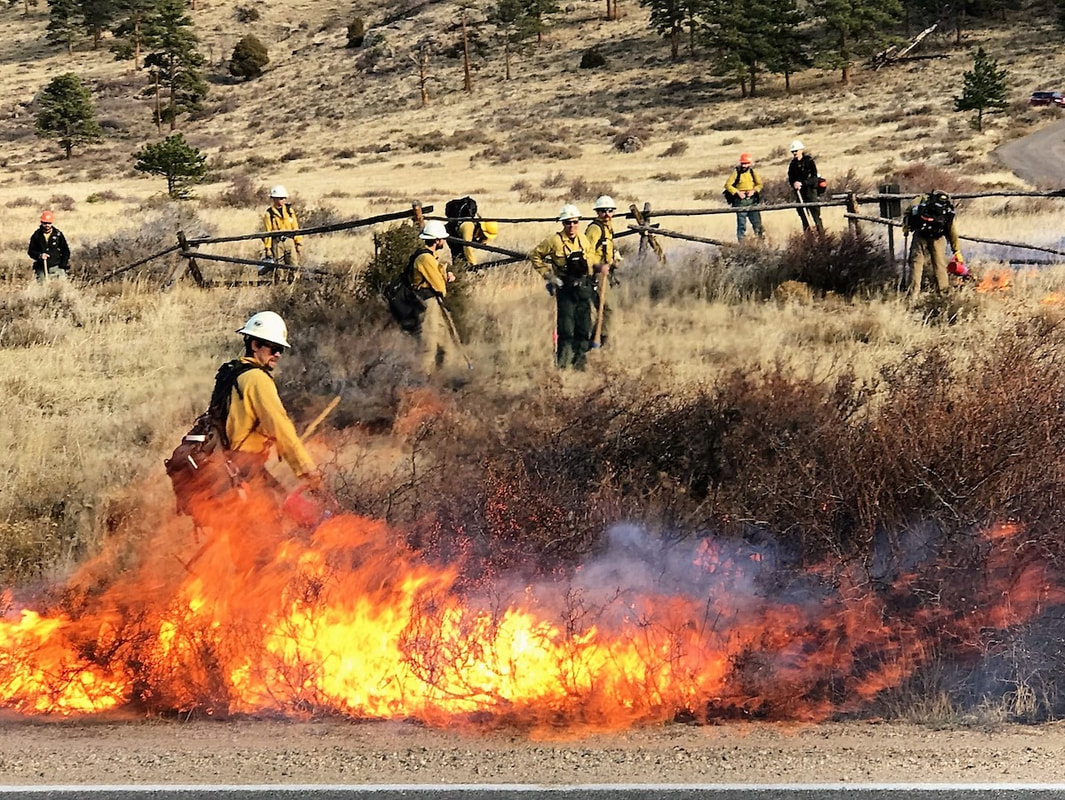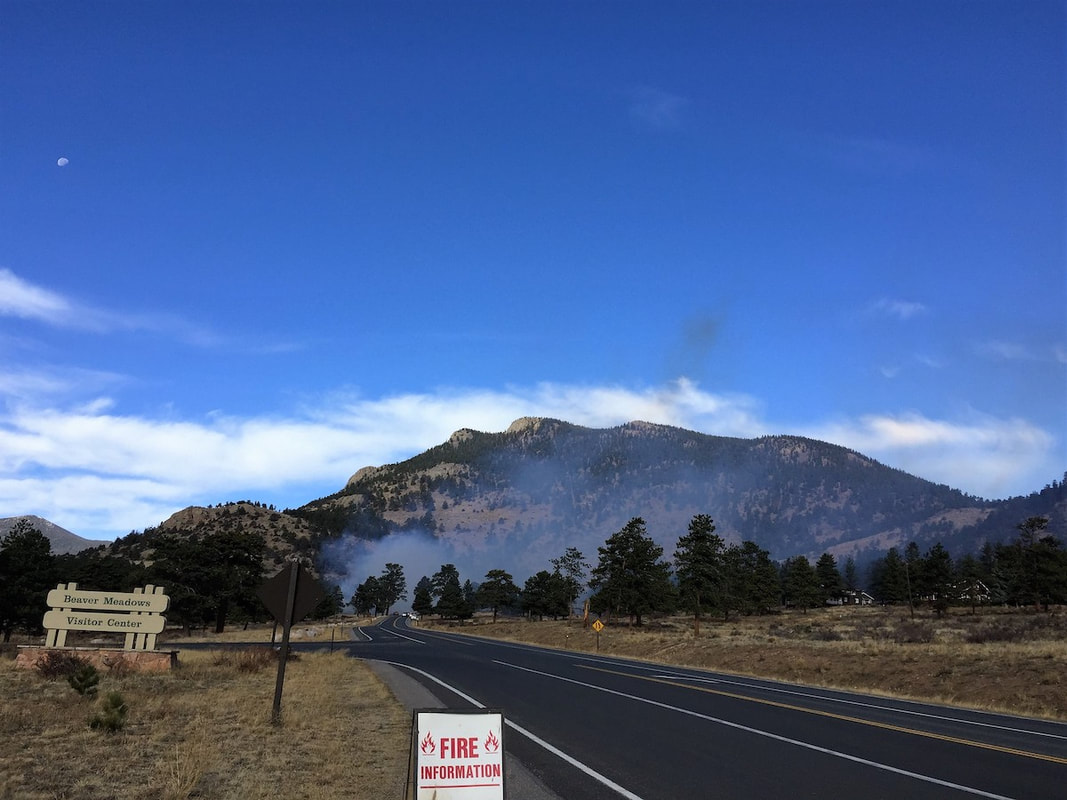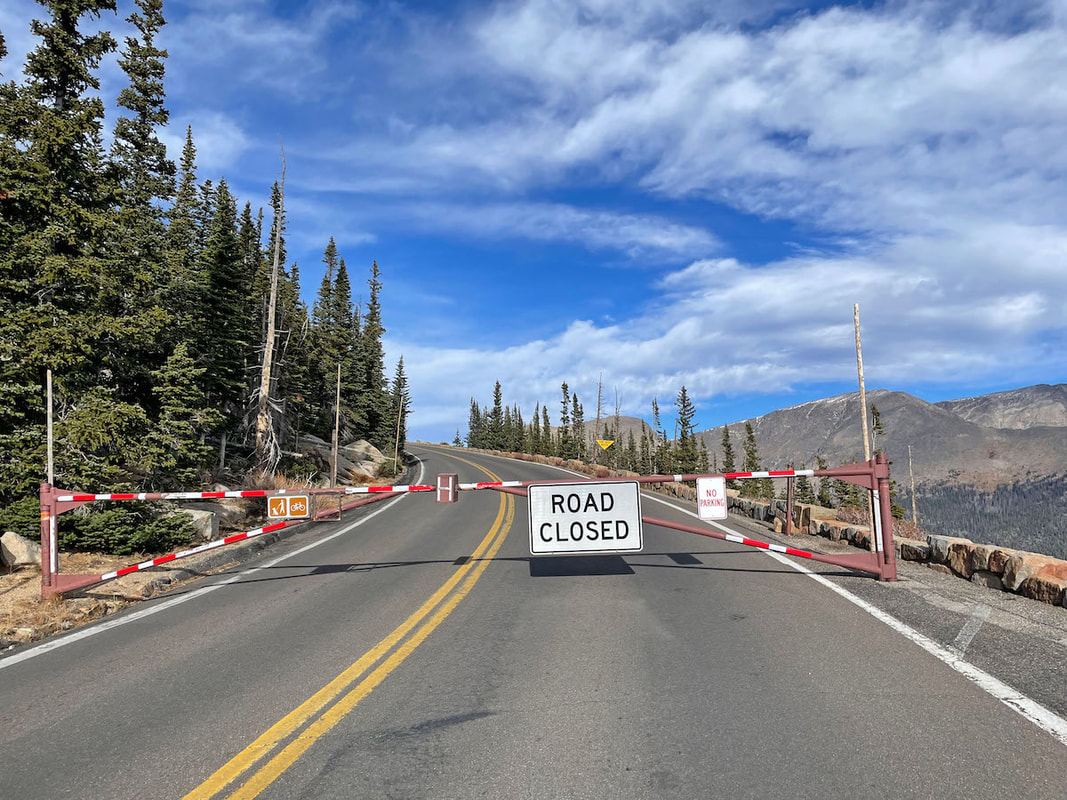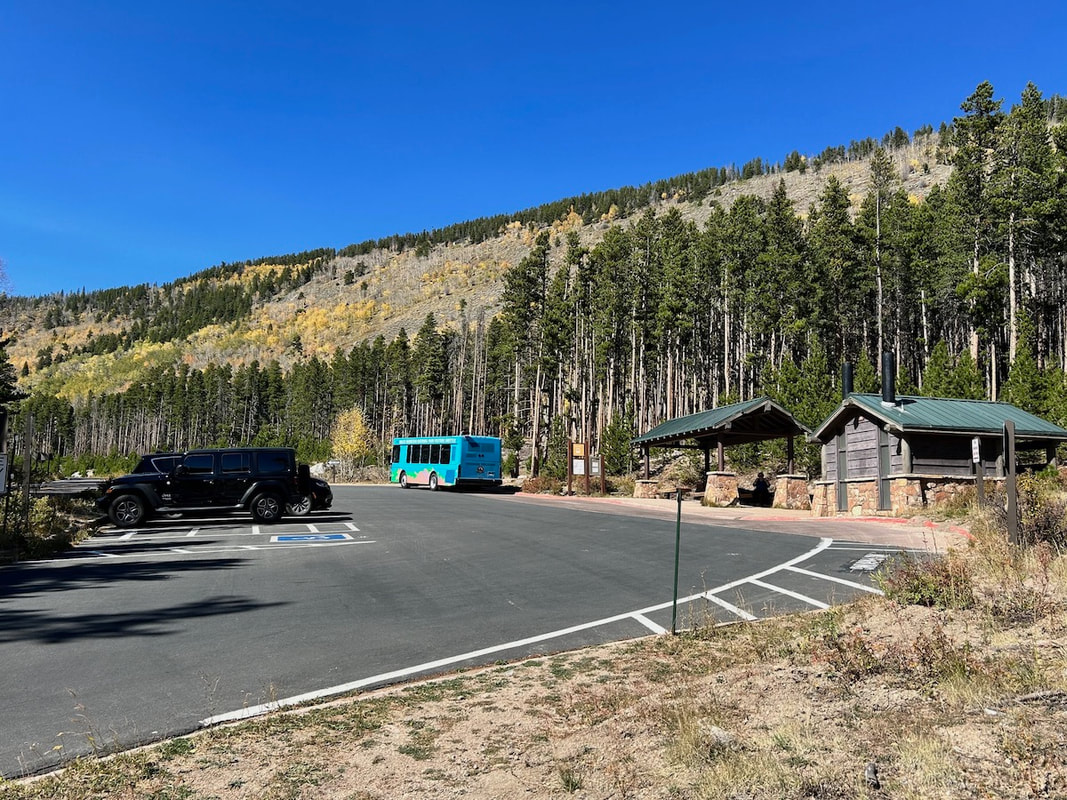|
Based upon the potential for favorable weather and fuels conditions, fire managers at Rocky Mountain National Park are planning to conduct a prescribed burn beginning on Monday, March 10, 2025. Firefighters plan to burn approximately 50 acres of the 334-acre Headquarters Unit. This burn unit is located inside Rocky Mountain National Park, west of the Beaver Meadows Visitor Center and south of U.S. Highway 36. Because of the fuel type that will be burned, which include mainly grasses, heavy and prolonged smoke is not expected from this operation. The primary goal of the project is to reduce the threat of wildland fire to adjacent communities and NPS infrastructure by using prescribed fire to reduce the amount of fuels available in this area. When fighting the East Troublesome Fire in 2020 and the Fern Lake Fire in 2012, firefighters were able to take advantage of previous and existing prescribed fire and hazardous fuels treatment areas that provided a buffer between the fires and the town of Estes Park. Prior hazard fuels projects were instrumental in stopping both fires from crossing Bear Lake and Trail Ridge Roads. If conditions are favorable, ignitions are planned to occur on Monday, March 10. Firefighters will be on scene for the duration of the operation and will be patrolling the burned area. Smoke from the prescribed burn will be visible throughout the day of the burn, mostly during the warmest part of the day. With cooler temperatures in the evening, smoke may linger and accumulate in low-lying areas. Fire operations near the Beaver Meadows Entrance to RMNP may cause brief delays or temporary road closures. Traffic may be diverted through Fall River Entrance. Motorists should watch for fire vehicles on the roads and allow extra time for entering and exiting the park. Traffic control will be in place on U.S. Highway 36 within the burn area. Additional information will be shared on InciWeb athttps://inciweb.wildfire.gov/incident-information/cormp-front-country-prescribed-fire and on RMNP’s official social media channels. For the safety of visitors and firefighters, park visitors will not be allowed to stop along U.S. Highway 36 within the burn area. Visitors will also not be able to walk within the burn area.
Smoke may be visible both inside and outside the park. Every effort will be made to minimize smoke impacts on visitors and the adjacent community; however, some smoke is anticipated to disperse east of the park. Smoke may affect your health: For more information see https://www.colorado.gov/pacific/cdphe/wood-smoke-and-health. Safety factors, weather conditions, air quality, personnel availability and environmental regulations are continually monitored as part of any fire management operation. For more information please contact the park Information Office at (970) 586-1206.
0 Comments
Rocky Mountain National Park and the Rocky Mountain Conservancy are accepting applications for the 2025 Bailey Research Fellowship. This program provides opportunities and support for qualified graduate students to conduct research inside the park and share their work with the public.
Graduate student researchers are important contributors to the field of science and to our understanding of Rocky Mountain National Park. Past Bailey Research Fellows have conducted projects focused on the following topics: habitat selection of white-tailed ptarmigan, disease susceptibility among boreal toad populations, elevational occupancy by pika subspecies, plant physiology and riparian ecosystem recovery, and risk analysis of antibiotic-resistant bacteria in soil and water. Staff with Rocky Mountain National Park and Rocky Mountain Conservancy are proud to support the next generation of park scientists and stewards through the Bailey Fellowship. Who can apply? Bailey Fellowship applicants must be currently enrolled graduate students, show excellence in research, have a career interest in work with public lands, and be able to communicate effectively with public audiences. This fellowship includes housing inside RMNP, a living stipend, and financial support for research supplies and professional conference attendance. Areas of research can include wildlife management, vegetation and riparian studies, fire ecology, cultural sciences, archeology, historic structures preservation, as well as topics in the fields of botany, zoology, geology, history, and ecology. All projects should aim to promote the informed decision making and adaptive management of Rocky Mountain National Park or the education of NPS staff to promote professional development and growth. For application guidelines and to apply, visit https://rmconservancy.org/work-with-us/bailey-research-fellowship/ Applications will be accepted through Sunday, February 16, 2025. For many, winter is their favorite time of year to visit Rocky Mountain National Park. Often, the park is less crowded. For those who are prepared, winter is an enchanting time to experience the beauty of the southern Rockies.
A great way to explore the wonders of the park in winter is to participate in one of Rocky’s ranger-led winter activities. Programs will take place on both the east and west sides of the park, weather and snow conditions permitting. Programs will be offered beginning in January 2025 through mid-March. New to Snowshoeing? East Side of RMNP (Near Estes Park, CO): Are you new to snowshoeing? Step into the basics and learn what snowshoeing is all about. Along the way, learn about plants and wildlife that call Rocky home. This beginner snowshoe walk is great for the whole family! Participants of all ages are welcome. Beginning on January 25, these programs will take place on Saturdays at 2 p.m. and they are 1-hour in length. For additional program details and to register, visit https://rmconservancy.org/rmnpsnowshoe/ West Side of RMNP (Near Grand Lake, CO): Join a family-friendly snowshoes walk! Designed for families with children ages 5 and older, these programs offer a great way for the whole family to get outside and explore the wonders of winter in Rocky. Family-friendly snowshoe walks will take place at 1 p.m. on the following Fridays: February 7, 14, 21, and 28. To make a reservation, call 970-586-1513. Looking for a More Adventurous Snowshoe Hike? East Side of RMNP: Enjoy an afternoon of winter exploration! Participants will travel across hilly, uneven, snow-covered meadows and forest areas 9,400-9,700 feet in elevation. Snowshoe hikes are 2-hours in duration. Along the way, participants will learn about plants and wildlife that call Rocky home. Beginning on January 28, snowshoe hikes will take place on Tuesdays and Thursdays at 12:30 p.m. For details and to register, visit https://rmconservancy.org/rmnpsnowshoe/ West Side of RMNP: Enjoy the quiet of winter in Rocky as you walk across a snow-covered landscape with a park ranger. Along the way, learn about plants and wildlife that call the park home. These programs are two-hours in length and participants will walk through hilly, uneven, snow-covered meadows and mixed conifer forest areas. These snowshoe walks are considered moderately strenuous and take place at 8,700-9,300 feet in elevation. Ranger-led snowshoe walks take place on Saturdays & Sundays at 1 p.m. To make a reservation, call 970-586-1513. To Participate in a Ranger-led Snowshoe Program, What Do I Need to Know? To attend any of RMNP’s ranger-led snowshoe programs, know that these programs are free (park entrance fees are required) and advanced reservations are required. No prior experience is needed. These programs are very popular and space is limited to 20 participants per program. Reservations can be made up to 7 days ahead of a scheduled program. All snowshoe programs will fill quickly. Due to poor weather or snow conditions, all programs may be cancelled last minute. If cancelled, participants will be notified. For all snowshoe programs happening on the west side of RMNP, snowshoes are provided for the duration of the program. For all snowshoe programs happening on the east side of RMNP, participants must bring their own snowshoes or rent them outside of the park. For the more adventurous snowshoe hikes, participants must have a baseline fitness level that allows them to snowshoe approximately one mile over hilly terrain at high elevation. Programs take place at higher elevations and may not be suitable for people sensitive to altitude. To Participate in one of Rocky’s Snowshoe Programs, What Do I Need to Bring? For your comfort and safety, appropriate clothing is essential. Recommended items include waterproof winter jacket, snow pants, warm socks, waterproof boots, gloves/mittens, a hat, and sunglasses or goggles. All participants should bring their own snacks and water. Enjoy Additional Ranger-led Activities This Winter East Side of RMNP – Experience Ice Fishing: Sprague Lake may be frozen, but the fish are still biting! Bundle up and give ice fishing a try. Beginning on January 19, join a ranger guide at Sprague Lake anytime from 10 a.m. to noon on Sundays and Fridays. Weather and conditions permitting, these programs will continue through mid-March. Ice fishing programs are drop-in programs and participants are welcome to come at any time and stay as long as they choose. Ice Fishing programs are free (park entrance fees are required) and no prior experience is needed. A valid Colorado fishing license is required for all persons 16 years of age or older who plan to fish. Due to icy conditions along the trails and walkways, all participants are strongly encouraged to bring their own, or rent, traction devices before arriving at the park. West Side of RMNP – Enjoy Ranger-led Cross-Country Ski Tours Do you like to go cross-country skiing? Would you like to go skiing with an experienced ranger guide? Beginning on Saturday, January 18, Ranger-led Cross-Country Ski Tours will be available on Saturdays at 10 a.m. Weather and snow conditions permitting, they will continue through March 15. To participate, some cross-country skiing experience is required and participants must be 16 or older. Advanced reservations are required. Space is limited to 12 people per program and the park’s ski tours are expected to fill quickly. To make a reservation, call 970-586-1513. Participants must bring or rent their own skis and appropriate clothing. Equipment rentals are available outside of the park. For More Information Thank you to Rocky Mountain Conservancy for their support of programs like these. For more information on Rocky’s winter activities, visit https://go.nps.gov/romo/winter-programs For information on Rocky Mountain National Park, call the Information Office at 970-586-1206 or visit the park’s website at www.nps.gov/romo Based upon the potential for favorable weather and fuels conditions early next week, fire managers at Rocky Mountain National Park are planning to burn either a 60-acre section of the Headquarters Prescribed Fire Unit or conduct a pile burning operation near Wild Basin which will be visible from Highway 7 beginning on Monday, December 9, 2024. Fire managers will be actively monitoring weather and fuels conditions between now and Monday morning to determine which fire operation will take place.
Last month, NPS fire staff worked with several partner agencies to burn 100 acres of the 334-acre Headquarters Prescribed Fire Unit. If conditions remain favorable, the 60 acres the park plans to burn next week make up the second section of this unit. Fire managers would burn in an area located inside Rocky Mountain National Park, west of the Beaver Meadows Visitor Center and south of U.S. Highway 36. Because of the fuel type that will be burned, which include mainly grasses and small shrubs, heavy and prolonged smoke is not expected from this operation. If fire managers decide that conditions are more conducive for a pile burning operation, the park plans to burn up to 500 slash piles located inside Rocky Mountain National Park near the Wild Basin area in the southern part of the park. Slash from several fuels reduction and hazard tree removal projects have been cut and piled by park fire crews and contractors over the last two years. These piles are now dry enough to burn. Pile burning operations only occur when weather and conditions allow. The primary goal of both of these burn operations is to reduce the threat of wildland fire to adjacent communities and to NPS infrastructure by reducing the amount of fuels available on the landscape. When fighting the East Troublesome Fire in 2020 and the Fern Lake Fire in 2012, firefighters were able to take advantage of previous and existing prescribed fire and hazardous fuels treatment areas that provided a buffer between the fires and the town of Estes Park. Prior hazard fuels projects were instrumental in stopping both fires from crossing Bear Lake and Trail Ridge Roads. If conditions are favorable for a prescribed fire, ignitions are planned to occur on Monday, December 9. Firefighters will be on scene for the duration of either operation and will patrol throughout the day and overnight. Fire operations near the Beaver Meadows Entrance to RMNP may cause delays or road closures. If closures take place, inbound and outbound traffic will be divered through Fall River Entrance. Motorists should watch for fire vehicles on the roads and allow extra time for entering and exiting the park. Additional information will be shared on InciWeb athttps://inciweb.wildfire.gov/incident-information/cormp-front-country-prescribed-fire and on RMNP’s official social media channels. NPS staff will be available at Beaver Meadows Visitor Center to answer questions. For the safety of visitors and firefighters, park visitors will not be allowed to stop along U.S. Highway 36 within the burn area. Visitors will also not be able to walk within the burn area. Smoke from either burn operation may be visible both inside and outside the park. With cooler temperatures in the evening, smoke may linger and accumulate in low-lying areas. Every effort will be made to minimize smoke impacts on visitors and the adjacent community; however, some smoke is anticipated to disperse east of the park. Smoke may affect your health: For more information see https://www.colorado.gov/pacific/cdphe/wood-smoke-and-health. Safety factors, weather conditions, air quality, personnel availability and environmental regulations are continually monitored as part of any fire management operation. For more information, contact the park Information Office at (970) 586-1206. Rocky Mountain National Park Announces the Opening of the 2025 Artist-in-Residence Application11/19/2024 Rocky Mountain National Park and the Rocky Mountain Conservancy are pleased to announce that the park’s Artist-In-Residence program will begin accepting applications for the summer 2025 season on Sunday, December 1, 2024. RMNP’s Artist-in-Residence program is open to artists of all creative disciplines and genres. Interested artists are invited to apply.
Art has played a major role in the creation of our national parks and in the preservation of our country’s wild spaces. Since the 1800s, artistic works have inspired people to travel, dream, explore, and visit their national parks and other public lands. Artist-in-Residence programs provide opportunities for artists to connect with our national parks and to gain inspiration for the creation of new artistic works. Rocky Mountain National Park, in partnership with the Rocky Mountain Conservancy, is one of over 50 National Park Service sites that currently host an Artist-In-Residence program. Selected artists will serve in a two-week residency within Rocky Mountain National Park. During their residency, selected artists will reside in a rustic cabin located inside RMNP where the artists can gain inspiration and create artistic works. Participating artists will also host and facilitate at least two free public programs for audiences of all ages. Applications for the summer 2025 program will be accepted beginning on December 1 and will close at 11:59 p.m. MST on January 31, 2025. For all details on application requirements and how to apply, visit Rocky Mountain National Park’s Artist-in-Residence webpage at https://go.nps.gov/romo/air Applications will be reviewed by a panel of judges. The panel will select at least five artists to participate in the 2025 Artist-in-Residence program. Selected artists will be notified in April and upon selection they will be able to choose a desired time block for their two-week residency from a list of available options. Established in 1984, RMNP was one of the first national parks to create an Artist-In-Residence program. This program was on hiatus from 2017-2023 while the program was being restructured. Over the past 30+ years, program participants have included painters, fiction writers, poets, photographers, textile artists, composers, sculptors, musicians, and more! Selected artists will stay at the William Allen White Cabin, a rustic, historic cabin located near Moraine Park. During their two-week residency, artists will have the opportunity to explore the park, gain inspiration, share their art with the public, and create new works. At the completion of their residency, the artists will donate a fully furnished piece of work representative of their stay to the Rocky Mountain Conservancy. Rocky Mountain Conservancy will hold the rights to the piece of work and the National Park Service will have the rights to share the donated works with the public. For more information on Rocky Mountain National Park, please call the park Information Office at (970) 586-1206 or visit our website at www.nps.gov/romo. Rocky Mountain National Park (RMNP) will implement its 2025 timed-entry reservation system, beginning May 23, 2025. This reservation system provides day use visitor access in a way that protects resources while creating opportunities for high-quality visitor experiences.
The system, established through the Day Use Visitor Access Plan finalized in May 2024, manages day use visitor access in a way that protects the park's resources, maintains positive visitor experiences, promotes safety, and supports the park’s ability to maintain daily operations. The system will be similar to 2024, with two types of reservations available. One permit will be for the Bear Lake Road Corridor, which includes the entire corridor, as well as access to the rest of the park. This reservation period will be from 5 a.m. to 6 p.m. The second permit will be for the “rest of the park,” excluding the Bear Lake Road corridor. This “rest of park” reservation period will be from 9 a.m. to 2 p.m. Permits issued using the reservation system will allow park visitors to enter the park within two-hour windows of availability, with no set time for departure. The reservation system will apply to all areas of the park. The only cost associated with booking a reservation is a $2 recreation.gov processing fee. The Bear Lake Road Corridor timed entry reservation system will end on Monday, Oct. 20. However, the rest of the park reservation system will end on Tuesday, Oct. 14. Reservations to enter the park will be available through www.recreation.gov following the below schedule.
RMNP is one of the most visited national parks. The park experienced a 44 percent increase in visitation from 2012 to 2019. In 2022, the park received 4.3 million visits. Even with a pilot vehicle reservation timed entry system in place, the park received some of the highest visitation in its history. Between 2016 and 2023, the park piloted several day-use visitor management strategies to address crowding, congestion, and impacts on park resources. These pilots demonstrated this strategy is effective at easing congestion impacts and improved the visitor experience in the park. The park also asked the public for their participation in envisioning the future of day use visitor access at RMNP during the summer of 2021 and the winter of 2022-2023. For further information about RMNP please visit www.nps.gov/romo, follow the park on social media @RockyNPS or call the park Information Office at (970) 586-1206. 11/2 Ignitions on the Headquarters Unit of the Front Country Prescribed Fire have been successfully completed, with approximately 100 acres treated during the past two days. Crews were successful in introducing low-to-moderate intensity fire on the landscape and have removed fuels, including grasses and low shrubs. Another goal of this prescribed fire was to raise the bottoms of the canopies of trees and to increase crown spacing within the fire area. To do this, some low branches on trees may burn in addition to the grasses and nearby brush. Raising the “crown base height” of trees decreases the likelihood that a future wildfire would move into the canopies of the trees. This work will help serve as a fuel break against potential future wildfires. Fire crews will remain on site overnight. Visibility along U.S. Highway 36 has improved and smoke will continue to linger. U.S. Highway 36 inside Rocky Mountain National Park has reopened in both directions. Fire Managers at Rocky Mountain National Park would like to thank all of the personnel involved in this operation over the past two days. Numerous cooperators, including federal, state, and local partners have been working with NPS staff in a variety of roles to ensure the safety of both firefighters and the visiting public. 11/2 Rocky Mountain National Park's Front Country Prescribed Fire operations continue today due to favorable conditions. Approximately 50 firefighters representing several cooperating agencies are part of today’s operations. Visitors traveling to the east side of Rocky Mountain National Park are encouraged to use Fall River Entrance via U.S. Highway 34 when entering and exiting the park. Expect traffic delays and smoke on the roadway along U.S. Highway 36 inside RMNP. Currently, U.S. Highway 36 is open to west-bound traffic only from Beaver Meadows VC to Beaver Meadows Entrance. Motorists are encouraged to use caution when driving on U.S. Highway 36 between the Beaver Meadows Visitor Center and Bear Lake Road due to smoke, visibility and fire crews working along the road. To exit RMNP on the east side of the park, visitors are directed to use Fall River Entrance/U.S. Highway 34 to return to Estes Park. In person fire information will be available at Beaver Meadows Visitor Center until 4:30 p.m. 11/1 Weather and fuels conditions remained favorable today for Rocky Mountain National Park's Front Country Prescribed Fire. NPS fire managers are being supported by numerous other fire resources. Visitors traveling on U.S. Highway 36 near Beaver Meadows Visitor Center and Beaver Meadows Entrance experienced minor delays and smoke. Firefighters completed ignitions at approximately 4:15 p.m. Crews remain in the field and will monitor the units that were burned overnight. Smoke was light to moderate through most of the day and dispersal went as anticipated. With cooler temperatures in the evening, smoke may linger and accumulate in low-lying areas. Firefighters are planning to continue with the prescribed fire tomorrow, if conditions allow. Stay tuned on Rocky's official social media channels and Inciweb (https://inciweb.wildfire.gov/incident-information/cormp-front-country-prescribed-fire) tomorrow for additional updates. 10/30 Based upon the arrival of cool weather and the amount of precipitation in the extended weather forecast, fire managers at Rocky Mountain National Park are preparing to conduct a prescribed burn if favorable weather and fuel conditions allow. Fire managers may burn up to a 300-acre area. This would take place west of the Beaver Meadows Visitor Center and south of U.S. Highway 36. Burning operations would be conducted over several days to limit daily smoke production. The primary goal of the project is to reduce the threat of wildland fire to adjacent communities and park infrastructure by using prescribed fire to reduce the amount of fuel available in this area. When fighting the East Troublesome Fire in 2020 and the Fern Lake Fire in 2012, firefighters were able to take advantage of previous and existing prescribed fire and hazardous fuels treatment areas that provided a buffer between the fire and the town of Estes Park. Prior hazard fuels projects were instrumental in stopping the fire from jumping Bear Lake Road and Trail Ridge Road. Depending on when and if weather and fuel conditions are suitable, prescribed burning operations may begin late October or any time through the winter. Ignitions will likely occur on weekdays with smoldering and smoke emissions lasting for an additional 3-10 days. If burning operations take place, traffic control will be in place on U.S. Highway 36 within the burn area. Smoke may be visible both inside and outside the park. Every effort will be made to minimize smoke impacts on visitors and the adjacent community; however, some smoke is anticipated to disperse east of the park. Smoke may affect your health: For more information see https://www.colorado.gov/pacific/cdphe/wood-smoke-and-health. No trail or road closures are anticipated but visitors passing through active burning areas may be escorted by fire personnel to ensure their safety. For the safety of visitors and firefighters, park visitors will not be allowed to stop along U.S. Highway 36 within the burn area. Visitors will also not be able to walk within the burn area. Safety factors, weather conditions, air quality, personnel availability and environmental regulations are continually monitored as a part of any fire management operation. For more information please contact the park’s Information Office at (970) 586-1206. Trail Ridge Road in Rocky Mountain National Park is Closed to Through Travel for the 2024 Season10/25/2024 Today, Friday, October 25, Trail Ridge Road (U.S. Highway 34) inside Rocky Mountain National Park (RMNP) officially closed for the season to through travel. With 11 miles of road located at elevations above 11,500 feet, few guard rails, and no shoulders, Trail Ridge Road is not designed to be an all-season road. Winter conditions of drifting snow, high winds and below- freezing temperatures occur above 10,000 feet. Trail Ridge Road is currently closed at Rainbow Curve on the east side of RMNP and at the Colorado River Trailhead on the west side of the park. Closure points on the road may fluctuate this fall, however the road is closed to through travel for the season. Interested in taking a scenic drive? There are several popular scenic driving destinations open this time of year, including Bear Lake Road, Endovalley Road, Trail Ridge Road on the west side of RMNP from Grand Lake Entrance to the Colorado River Trailhead and Trail Ridge Road on the east side of RMNP to Rainbow Curve. Trail Ridge Road normally opens the last week in May, weather permitting. In 2024, Trail Ridge Road opened on Friday, May 31. Old Fall River Road closed to vehicles for the season on October 8. Trail Ridge Road and Old Fall River Road will remain open to bicycles, hikers, and people walking leashed pets through November 30. Leashed pets and bicycles are only allowed on the roads, not on side trails. On December 1, both roads will transition to "winter trail status." On Sunday, December 1, 2024, bicycles and leashed pets will no longer permitted to travel beyond the closed gates. Pedestrians, snowshoers and skiers will be welcome to recreate during the winter season on both roads. For more information about Rocky Mountain National Park, please visit www.nps.gov/romo or call the park’s Information Office at (970) 586-1206. Due to freezing temperatures and precipitation turning to snow accumulation at higher elevations, Trail Ridge Road, which is US Highway 34 through Rocky Mountain National Park is temporarily closed at Milner Pass on the west side of the park and Rainbow Curve on the east side of the park. Trail Ridge Road recorded status line will be updated when and if the road status changes (970) 586-1222.
Beginning on Monday, October 7, 2024, the Bierstadt Lake parking area, located on Bear Lake Road on the east side of Rocky Mountain National Park, will be closed for a vault toilet replacement project. Weather and conditions permitting, this parking area, including a shuttle stop, will be closed for approximately six weeks.
This project involves removing the existing vault toilet infrastructure which has exceeded its service life and installing a new vault toilet building. These needed improvements are funded by visitor recreation fees. Due to the equipment necessary to complete this project, the size of the parking area and entrance and exit areas, the Bierstadt Lake parking area will be closed for the duration of the project. There will be no vehicle access and shuttle service will not be available at this stop. Vehicles will not be permitted to stop in the lane of traffic on Bear Lake Road to load/unload passengers. There are numerous trails that lead to Bierstadt Lake, including from Bear Lake, Hollowell Park and Park and Ride. To board the park’s free shuttles and to access other destinations along Bear Lake Road, hikers will have to use alternate trailheads. For more information on Rocky Mountain National Park, visit our website at www.nps.gov/romo or call the park’s Information Office at (970) 586-1206. |
RMNP UpdatesPress Releases from Rocky Mountain National Park and the Rocky Mountain Conservancy.
Archives
September 2025
|
© Copyright 2025 Barefoot Publications, All Rights Reserved
